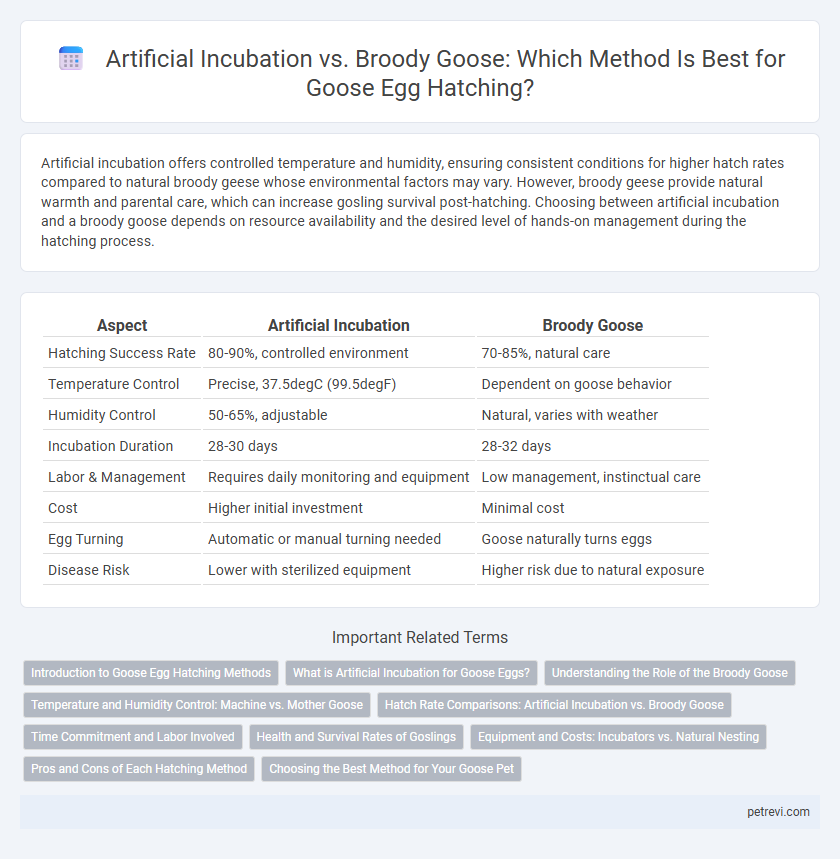Artificial incubation offers controlled temperature and humidity, ensuring consistent conditions for higher hatch rates compared to natural broody geese whose environmental factors may vary. However, broody geese provide natural warmth and parental care, which can increase gosling survival post-hatching. Choosing between artificial incubation and a broody goose depends on resource availability and the desired level of hands-on management during the hatching process.
Table of Comparison
| Aspect | Artificial Incubation | Broody Goose |
|---|---|---|
| Hatching Success Rate | 80-90%, controlled environment | 70-85%, natural care |
| Temperature Control | Precise, 37.5degC (99.5degF) | Dependent on goose behavior |
| Humidity Control | 50-65%, adjustable | Natural, varies with weather |
| Incubation Duration | 28-30 days | 28-32 days |
| Labor & Management | Requires daily monitoring and equipment | Low management, instinctual care |
| Cost | Higher initial investment | Minimal cost |
| Egg Turning | Automatic or manual turning needed | Goose naturally turns eggs |
| Disease Risk | Lower with sterilized equipment | Higher risk due to natural exposure |
Introduction to Goose Egg Hatching Methods
Goose egg hatching methods primarily include artificial incubation and natural brooding by a broody goose, each with specific advantages. Artificial incubation offers controlled temperature, humidity, and turning conditions to maximize hatch rates and reduce risks from predators or environmental factors. Broody geese provide natural warmth and protection, promoting instinctive care but with variable success influenced by the hen's behavior and external conditions.
What is Artificial Incubation for Goose Eggs?
Artificial incubation for goose eggs involves using controlled temperature, humidity, and turning mechanisms within an incubator to replicate the natural conditions required for embryo development. This method allows precise monitoring and adjustment of environmental factors, often resulting in higher hatch rates compared to relying solely on a broody goose. Artificial incubation is especially useful in commercial or large-scale hatching operations where consistent results and increased productivity are essential.
Understanding the Role of the Broody Goose
The broody goose naturally regulates the incubation temperature and humidity, ensuring optimal conditions for embryonic development and increasing hatch rates compared to artificial incubation. Its innate behavior includes periodic turning of eggs, which prevents embryo adhesion and promotes uniform growth, a detail often challenging to replicate in artificial incubators. Recognizing the broody goose's role in enhancing hatching success highlights the importance of balancing natural instincts with technological approaches in goose egg incubation.
Temperature and Humidity Control: Machine vs. Mother Goose
Artificial incubation offers precise temperature control, typically maintaining a constant 99.5degF (37.5degC), essential for optimal goose egg development, while humidity is regulated around 55-65% with adjustments during different incubation stages. In contrast, a broody goose naturally provides fluctuating temperature and humidity levels, averaging around 97-100degF, creating a more variable but biologically adaptive microenvironment for embryonic growth. Mechanical incubators ensure consistent conditions, reducing risks of overheating or dehydration, whereas the mother goose's instinctive behavior allows for natural responses to external changes and egg positioning.
Hatch Rate Comparisons: Artificial Incubation vs. Broody Goose
Artificial incubation typically yields hatch rates between 70% to 85%, benefiting from controlled temperature and humidity settings that optimize embryonic development. In contrast, broody geese often achieve hatch rates around 60% to 75%, influenced by natural variations in nest temperature and parental attentiveness. Monitoring precise incubation conditions in artificial systems generally results in more consistent and higher hatch rates compared to the variability inherent in natural brooding behavior.
Time Commitment and Labor Involved
Artificial incubation of goose eggs demands consistent temperature and humidity control, requiring daily monitoring and adjustment through equipment like incubators, which can be labor-intensive but allows for precise environmental regulation. Broody geese naturally incubate eggs with minimal human intervention, reducing labor but requiring the owner to manage the goose's comfort and protect the nest from predators, often extending the hatching period by several days compared to artificial methods. Time commitment for artificial incubation is concentrated in setup and daily checks, whereas with broody geese, the commitment spans the entire natural incubation period, typically 28 to 35 days.
Health and Survival Rates of Goslings
Artificial incubation offers controlled temperature and humidity conditions that enhance hatch consistency and reduce the risk of infection, often resulting in higher survival rates for goslings. Broody geese provide natural warmth and turning, which supports stronger immune system development through maternal contact, potentially improving long-term health. However, goslings hatched under broody geese may face higher initial mortality due to environmental variability and predation risks compared to the regulated environment of artificial incubators.
Equipment and Costs: Incubators vs. Natural Nesting
Artificial incubation of goose eggs requires specialized incubators with precise temperature and humidity controls, often costing several hundred dollars, along with electricity expenses. In contrast, using a broody goose for natural hatching involves minimal equipment expenses, as the goose provides natural warmth and egg turning, reducing operational costs significantly. While incubators offer scalability and control, broody geese represent a cost-effective, low-maintenance option with no need for additional technology.
Pros and Cons of Each Hatching Method
Artificial incubation offers precise temperature and humidity control, resulting in higher hatch rates and the ability to hatch large batches simultaneously, but it requires significant investment and technical knowledge. Broody geese provide natural incubation with parental care, enhancing chick survival and social behavior, yet their reliability varies and hatching capacity is limited by the number of broody hens. Balancing technological control with natural behaviors is essential for optimizing hatch success in goose egg production.
Choosing the Best Method for Your Goose Pet
Artificial incubation offers precise temperature and humidity control, ensuring consistent conditions ideal for hatching goose eggs. A broody goose provides natural warmth and turning, promoting stronger chick development through maternal care. Selecting the best method depends on factors like available equipment, experience level, and the health and temperament of your goose pet.
Artificial incubation vs Broody goose for Goose egg hatching Infographic

 petrevi.com
petrevi.com